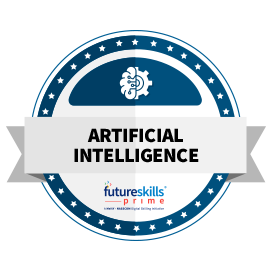Course Provider

What will you learn in this course?
At the end of this course, you should be able to:
- Understand list, array, linked list, stack, queue.
- Perform sorting and searching algorithms.
- Perform maps & hashing algorithms.
- Perform different operations on binary and advance trees algorithms.
- Perform graph algorithms.
- Execute different case studies like dynamic programming and greedy algorithm.
Data Structures & Algorithms
-
 Skill Type
Emerging Tech
Skill Type
Emerging Tech -
 Domain
Artificial Intelligence
Domain
Artificial Intelligence -
 Course Category
Deepskilling Course
Course Category
Deepskilling Course -
 Course Covered under GoI Incentive
No
Course Covered under GoI Incentive
No -
-
 Course Price
FREE
Course Price
FREE -
 Course Duration
10 Hours
Course Duration
10 Hours
-
Why should you take this course?
At the end of this course, you should be able to:
- Understand list, array, linked list, stack, queue.
- Perform sorting and searching algorithms.
- Perform maps & hashing algorithms.
- Perform different operations on binary and advance trees algorithms.
- Perform graph algorithms.
- Execute different case studies like dynamic programming and greedy algorithm.
Who should take this course?
- BE/ BTech students-any stream
- Non-engineering students-STEM background
- Working Professionals
Curriculum
- This course introduces the various data structures & algorithm techniques to be applied to the data to make it fit for further analysis. The course is divided into 7 modules which cover the important topics for data structures & algorithms:
- The first one is introduction & efficiency which talks about algorithm efficiency, complexity notation.
- Next one is list based on collections. This discusses how processes such as creation, insertion, deletion, and manipulation can be applied on a list, string, array, linked list, stack, and queues.
- The third module is searching & sorting. This module describes algorithms such as binary search, bubble sort, merge sort, quick sort, and recursion.
- The fourth module, maps & hashing, explores maps, hashing, and collision algorithms.
- The fifth module, trees, describes binary search tree, advanced tree, and their different operations.
- The sixth module, graphs, explores different operations of graphs.
- The seventh module, the case study, talks about the shortest path problem, dynamic programming, and traveling salesman problem.
- A Machine Learning engineer needs to preprocess the data as a part of EDA, write algorithms to build models. So, a good foundation in the DSA course is essential.
Tools you will learn in the course
- DSA
- Linked List
- Stack
- Queue
- Trees
- Graphs
- Searching & Sorting



